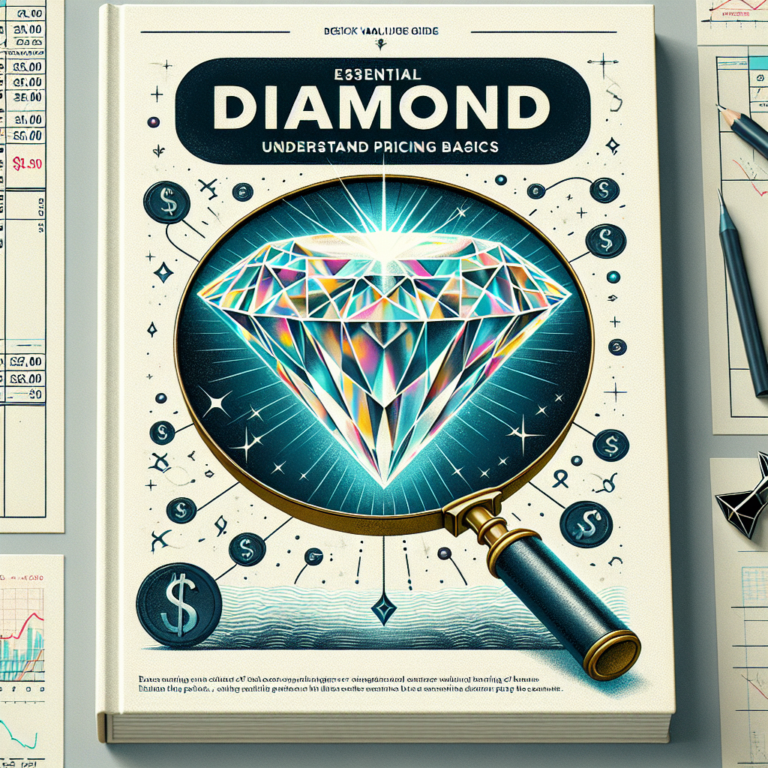Essential Diamond Value Guide: Understand Pricing Basics
Understanding diamond value and pricing can be daunting, especially for novice buyers. This Essential Diamond Value Guide will provide you with the foundational knowledge necessary to navigate the world of diamonds confidently. By the end of this guide, you’ll have a clearer understanding of what contributes to a diamond’s worth and how to make a judicious purchase.
The Four Cs: The Backbone of Diamond Pricing
When it comes to evaluating the price of a diamond, the Four Cs — Carat, Cut, Color, and Clarity — serve as the fundamental criteria:
1. Carat Weight
Carat weight denotes how much a diamond weighs. One carat is equivalent to 0.2 grams. As weight increases, so does the price, due to the rarity of larger diamonds. For instance, a diamond weighing 2 carats might cost significantly more than two 1-carat diamonds, even though they have the same total weight.
2. Cut
The cut of a diamond significantly affects its brilliance and sparkle. While often confused with shape, cut refers to how well the facets of the diamond interact with light. A well-cut diamond will reflect light beautifully, leading to higher prices. For example, a round-cut diamond often commands a premium due to its popularity and the skill required to cut it precisely.
3. Color
Diamonds are graded on a color scale from D (colorless) to Z (light yellow). Colorless diamonds are the most valued because they allow more light to pass through, enhancing their brilliance. According to the GIA (Gemological Institute of America), colorless diamonds can demand prices up to 15% higher than near-colorless diamonds.
4. Clarity
Clarity refers to the presence of inclusions and blemishes within and on the surface of the diamond. A clarity grading scale ranges from Flawless (no inclusions visible under 10x magnification) to Included (inclusions visible to the naked eye). The clearer the diamond, the more valuable it is, making flawless diamonds rarer and more expensive.
Market Trends and Their Impact on Pricing
Understanding current market trends can help inform your purchasing decisions. According to a recent report by the Rapaport Price List, diamonds have seen a moderate increase in pricing, particularly for larger stones. For instance, prices for diamonds over 2 carats have risen by approximately 5% over the past year.
Additionally, the Lab-Grown Diamond market has emerged as a significant alternative, with costs generally 20-40% lower than their mined counterparts. Buyers willing to explore this avenue can find excellent value without sacrificing quality.
Examples of Diamond Pricing
To illustrate the principles discussed, consider the following example:
-
1-Carat Round Diamond
- Cut: Ideal
- Color: G
- Clarity: VS2
- Estimated Price: $5,500
- 2-Carat Round Diamond
- Cut: Excellent
- Color: H
- Clarity: SI1
- Estimated Price: $12,000
In this case, the substantial price difference is influenced not only by carat weight but also by the collective impact of the cut, color, and clarity on overall aesthetics and rarity.
How to Use This Diamond Value Guide
When shopping for a diamond, it’s essential to arm yourself with knowledge. Always compare multiple options and ensure that any diamond you consider comes with certification from recognized organizations such as the GIA or AGS.
Tips for Buyers
- Set a Budget: Understand how each of the Four Cs can affect pricing and settle on which aspects are most important to you.
- Ask Questions: Don’t hesitate to ask jewelers for detailed information regarding the diamond’s characteristics and certification.
Visual Aids to Enhance Understanding
Convincing imagery can enrich your understanding as you navigate diamond purchases. Below are two suggested images:
-
Image of the Four Cs Chart
- Alt text: "Four Cs of Diamonds: Carat, Cut, Color, Clarity – Essential Diamond Value Guide"
- Image of a Gemological Certification
- Alt text: "Gemological Certification Example – Understanding Diamond Value Guide"
Internal and External Resources for Further Exploration
For more in-depth information, consider exploring:
- Understanding Diamond Grading
- The Impact of Diamond Origin on Pricing
- Lab-Grown vs. Natural Diamonds: What You Need to Know
Additionally, for external insights, check out National Jeweler and The Rapaport Group for industry trends.
Call to Action: Keep Learning
Equipped with this Essential Diamond Value Guide, you’re better prepared to make informed purchasing decisions. To stay updated on diamond pricing trends and become a savvy buyer, subscribe to our newsletter. For personalized advice or further inquiries, don’t hesitate to contact us. Your journey into the sparkling world of diamonds starts now!


